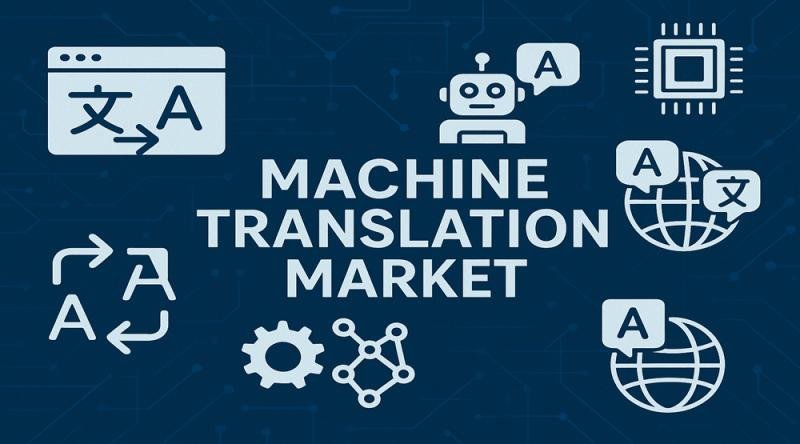The machine translation market is at the heart of the digital communication revolution, bridging language barriers and empowering global collaboration. As businesses, governments, and consumers increasingly operate across borders, the demand for fast, accurate, and scalable translation solutions has surged. Leveraging advancements in artificial intelligence (AI), natural language processing (NLP), and neural networks, machine translation has evolved beyond basic phrase conversion to contextually aware, domain-specific solutions that enable multilingual communication in real time.
This strategic article explores the leading companies, their competitive positioning, the combined SWOT analysis, and the key investment trends shaping the future of the machine translation industry.
Get deeper insights into competitive positioning and strategic benchmarking: Download our sample Machine Translation Market report here → https://www.researchnester.com/sample-request-4767
Top Companies & Their Strategies
1. Google LLC (United States)
Google Translate remains one of the most recognized machine translation platforms globally, supporting over 130 languages. Google’s strength lies in its deep neural network (NMT) architecture and integration with its vast ecosystem-Android, Chrome, YouTube, and Google Cloud.
The company’s strategy focuses on contextual accuracy and AI-driven personalization. Its continuous improvement through reinforcement learning and crowdsourced data enhances linguistic nuance and regional dialect handling. Google’s large-scale cloud infrastructure and cross-platform accessibility cement its leadership in both consumer and enterprise translation services.
2. Microsoft Corporation (United States)
Microsoft Translator offers AI-powered translation services integrated into Office 365, Teams, Azure Cognitive Services, and Bing. Its key strength is enterprise integration-embedding translation capabilities into collaboration tools, business workflows, and customer service platforms.
The company’s strategy prioritizes real-time speech translation and multimodal AI for text, audio, and video. Microsoft’s investment in edge computing and on-device translation enables low-latency, privacy-focused solutions, particularly valuable for regulated industries such as healthcare and finance.
3. Amazon Web Services (AWS) (United States)
Amazon Translate, part of AWS AI services, provides scalable neural machine translation for developers and enterprises. Its major advantage is customizability-allowing clients to train domain-specific models for e-commerce, legal, and technical documentation.
Amazon’s strategy emphasizes integration within enterprise cloud ecosystems, combining translation with voice recognition, chatbot, and data analytics tools. The company’s continuous focus on improving data privacy and multilingual scalability aligns with global enterprise localization needs.
4. DeepL SE (Germany)
DeepL has quickly emerged as one of the most accurate and context-sensitive translation platforms in the market. Its proprietary neural network design and data curation methods enable higher linguistic precision, especially for European languages.
DeepL’s strategy focuses on premium translation quality and enterprise-grade security. It has gained traction among professionals and corporations seeking human-like translations for legal, academic, and creative content. With an expanding presence in Asia and North America, DeepL’s competitive edge lies in linguistic depth and privacy assurance.
Explore detailed profiles of top players and new entrants in this space – access your free sample report → https://www.researchnester.com/sample-request-4767
5. SYSTRAN International (France)
SYSTRAN is a pioneer in the machine translation industry, with decades of experience in rule-based and hybrid translation systems. The company serves enterprise clients across defense, manufacturing, and finance sectors.
Its strategy centers on AI-human hybrid models, enabling domain adaptation and compliance with data sovereignty regulations. SYSTRAN’s open architecture allows customization and integration with private networks-an advantage for industries requiring high confidentiality and on-premise solutions.
6. IBM Corporation (United States)
IBM Watson Language Translator is part of IBM’s broader cognitive computing suite. The company leverages its AI capabilities to deliver context-aware and sentiment-driven translation, primarily targeting enterprise clients.
IBM’s strategy revolves around AI explainability and transparency, providing businesses with interpretable models and strong data governance. Its ability to integrate translation into broader AI analytics and automation frameworks strengthens its enterprise value proposition.
7. PROMT LLC (Russia/Europe)
PROMT specializes in AI-assisted translation solutions tailored for corporate, government, and defense clients. Its hybrid translation models combine neural and rule-based technologies, offering accuracy in technical and scientific domains.
The company’s focus on data security and offline translation positions it as a trusted vendor in regulated sectors. PROMT’s regional expertise, particularly in Eastern European and Asian languages, provides an edge in localized content adaptation.
8. Lilt Inc. (United States)
Lilt represents the next generation of machine translation-combining adaptive neural networks with human-in-the-loop learning. Its translation engine continuously improves based on feedback from professional linguists, offering real-time refinement.
Lilt’s strategy targets enterprise localization for technology, e-commerce, and life sciences. By merging automation with human expertise, Lilt delivers accuracy, cultural nuance, and scalability-bridging the gap between raw machine translation and professional linguistic quality.
View our Machine Translation Market Report Overview here: https://www.researchnester.com/reports/machine-translation-market/4767
Combined SWOT Analysis of Leading Machine Translation Companies
Strengths
Leading companies in the machine translation market leverage advanced AI architectures, large-scale data training, and cross-platform integration. Their ability to deliver high accuracy, real-time translation, and domain adaptation drives adoption across industries. Global players like Google, Microsoft, and Amazon dominate through ecosystem integration, while DeepL and Lilt excel in quality and specialization. The growing availability of cloud APIs and neural frameworks has democratized access to translation technology worldwide.
Weaknesses
Despite technological advancements, the industry continues to face accuracy limitations in low-resource languages and context-dependent content, such as idioms and cultural expressions. Data privacy and ethical AI concerns also remain significant, especially in sectors handling sensitive information. For smaller companies, competing with the computational and data resources of tech giants poses scalability challenges. Additionally, high R&D costs and the need for continuous model training can constrain profitability in a highly competitive environment.
Opportunities
The expansion of cross-border e-commerce, digital media, and global remote work is fueling demand for real-time translation. Multimodal translation-integrating text, voice, and image-is emerging as a major frontier, particularly in customer service, streaming, and education. Growth in low-resource language translation, AI localization, and speech-to-speech systems offers new business models. Emerging regions in Asia Pacific, Latin America, and the Middle East present untapped opportunities for language diversity and digital inclusion.
Threats
The machine translation market faces increasing competition from open-source models and rapid AI commoditization. Privacy regulations such as GDPR and evolving AI governance frameworks could restrict data usage for training purposes. Additionally, overreliance on a few dominant technology providers may create systemic risks for enterprise clients. Cultural misinterpretation and misuse of translation in legal or healthcare settings can also lead to reputational or regulatory challenges for companies operating at scale.
Interested in a customized SWOT for your target competitor? Request your tailored assessment → https://www.researchnester.com/sample-request-4767
Investment Opportunities & Trends
The machine translation market has become a key area for AI investment, reflecting the global need for multilingual communication and data accessibility. The past 12 months have witnessed heightened venture funding, strategic acquisitions, and technology collaborations across the ecosystem.
1. M&A Activity and Strategic Partnerships
Mergers and acquisitions continue to shape the competitive landscape as large technology firms expand their AI language capabilities.
• Google has enhanced its translation stack through deep learning R&D partnerships and open AI research collaborations.
• Microsoft integrated AI-driven translation deeper into its productivity tools and cloud services through acquisitions and internal innovation.
• Amazon and IBM have invested in startups specializing in real-time translation for customer engagement and video communication.
• DeepL secured additional funding to expand into enterprise services and introduce new language pairs tailored for Asia.
This consolidation highlights the industry’s push toward full-stack language AI ecosystems that combine translation, transcription, and sentiment analysis.
2. Startup Funding and Innovation in Neural Translation
The startup landscape remains vibrant, focusing on AI-augmented translation, edge computing, and contextual personalization. Companies like Lilt, Unbabel, and Papercup have attracted funding for adaptive translation models and media localization technologies.
Investors are increasingly drawn to AI-human hybrid systems that combine automation with editorial oversight. The success of startups specializing in niche domains-legal, medical, and media-underscores the growing demand for domain-specific translation intelligence.
3. Technology Integration and Cross-Sector Expansion
Technological convergence is redefining how machine translation is deployed across industries. Speech recognition, voice AI, and real-time collaboration platforms are becoming integrated with translation engines to deliver seamless multilingual experiences.
• In education, institutions are using real-time translation for remote learning and international collaboration.
• In healthcare, AI translation supports multilingual patient communication and document digitization.
• E-commerce and streaming platforms increasingly rely on translation AI for global customer engagement and content localization.
The trend toward API-based modular integration enables organizations to embed translation functions directly into apps, chatbots, and analytics platforms-creating an interconnected ecosystem of multilingual intelligence.
4. Regional Hotspots and Policy Support
Asia Pacific has emerged as a focal point for investment due to its linguistic diversity and digital transformation initiatives. Countries such as Japan, China, and India are investing in AI translation infrastructure for public services, tourism, and e-governance.
Europe continues to lead in ethical AI research, data privacy standards, and cross-border collaboration projects under the European Language Data Space (ELDS) initiative. Meanwhile, North America remains the largest hub for commercialization, with strong venture capital inflows and enterprise adoption.
Get exclusive intelligence on M&A, funding pipelines and regional opportunities: Download your sample report → https://www.researchnester.com/sample-request-4767
Related News:
https://www.linkedin.com/pulse/what-future-digital-transformation-consulting-services-ehsyf
https://www.linkedin.com/pulse/how-defect-management-tools-transforming-software-quality-obhof
Contact Data
AJ Daniel
Corporate Sales, USA
Research Nester
77 Water Street 8th Floor, New York, 10005
Email: info@researchnester.com
USA Phone: +1 646 586 9123
Europe Phone: +44 203 608 5919
About Research Nester
Research Nester is a one-stop service provider with a client base in more than 50 countries, leading in strategic market research and consulting with an unbiased and unparalleled approach towards helping global industrial players, conglomerates and executives for their future investment while avoiding forthcoming uncertainties. With an out-of-the-box mindset to produce statistical and analytical market research reports, we provide strategic consulting so that our clients can make wise business decisions with clarity while strategizing and planning for their forthcoming needs and succeed in achieving their future endeavors. We believe every business can expand to its new horizon, provided a right guidance at a right time is available through strategic minds.
This release was published on openPR.















